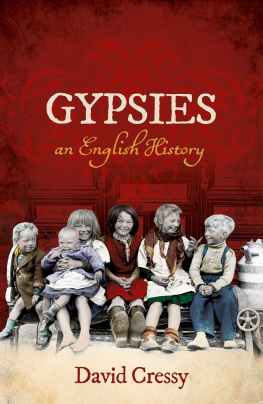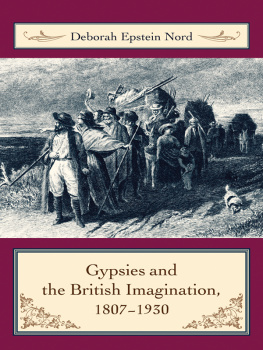
Gypsy Identities 15002000
Gypsies have lived in England since the early sixteenth century, yet considerable confusion and disagreement remain over the precise identity of the group. The question Who are the Gypsies? is still asked and the debates about the positioning and permanence of the boundary between Gypsy and non-Gypsy are contested as fiercely today as at any time before.
This study locates these debates in their historical perspective, tracing the origins and reproduction of the various ways of defining and representing the Gypsy from the early sixteenth century to the present day. Starting with a consideration of the early modern description of Gypsies as Egyptians, land pirates and vagabonds, the volume goes on to examine the racial classification of the nineteenth century and the emergence of the ethnic Gypsy in the twentieth century. The book closes with an exploration of the long-lasting image of the group as vagrant and parasitic nuisances which spans the whole period from 1500 to 2000.
David Mayall is Principal Lecturer in Social and Political History at Sheffield Hallam University.
Gypsy Identities 15002000
From Egipcyans and Moon-men to the
Ethnic Romany
David Mayall
LONDON AND NEW YORK
First published 2004
by Routledge
11 New Fetter Lane, London EC4P 4EE
Simultaneously published in the USA and Canada
by Routledge
29 West 35th Street, New York, NY 10001
Routledge is an imprint of the Taylor & Francis Group
This edition published in the Taylor & Francis e-Library, 2005.
To purchase your own copy of this or any of Taylor & Francis or Routledge's collection of
thousands of eBooks please go to www.eBookstore.tandf.co.uk .
2004 David Mayall
All rights reserved. No part of this book may be reprinted or reproduced or utilised in any form or by any electronic, mechanical, or other means, now known or hereafter invented, including photocopying and recording, or in any information storage or retrieval system, without permission in writing from the publishers.
British Library Cataloguing in Publication Data
A catalogue record for this book is available from the British Library
Library of Congress Cataloging in Publication Data
History of Gypsy identities/David Mayall.
p. cm.
Includes bibliographical references and index.
1. RomaniesGreat Britain. 2. RomaniesEthnic identity. I. Title.
DX211.M43 2003
941. 00491497dc21 2003008887
ISBN 0-203-49005-3 Master e-book ISBN
ISBN 0-203-59677-3 (Adobe eReader Format)
ISBN 1-857-28960-9 (hbk)
Contents
Preface
Gypsies have lived continuously in England since the early sixteenth century and yet, even today, there is still considerable confusion and disagreement over the precise identity of the group. The first question asked of anyone undertaking research into the Gypsies is Who do you mean by Gypsy? Behind this enquiry is a desire to define the group, fix the boundaries and find reassurances for the preconceptions which exist in the questioner's mind. But the reason the question has to be asked in the first place is precisely because so many different definitions and representations of the group compete with each other in contemporary society. The answer is neither simple nor easy, raising as it does issues of representation, perception, classification and criteria for group formation. As a result, the debates about where the boundary between Gypsy and non-Gypsy should be drawn, and whether the division is permanent or fluid, are argued as fiercely today as at any time. As with any minority group, the issue of identity is a critical feature of group relations and responses, and boundaries, labels and stereotypes are rarely constant or consistent. The conflicts and confusion which surround the specific case of Gypsy identity are both long lasting and seemingly unresolveable. My concern is with how the people, their origins and behaviour, culture and way of life are presented and constructed. This incorporates views on the Gypsy essence and what it is that defines and makes a Gypsy. The focus is thus on the Other at home, the outsider inside the nation, and how knowledge, information and, importantly, misinformation about the group emerge and gain credibility and acceptance.
This study covers a long historical period, touches on the work of specialists from other disciplines and deals with themes and concepts about which there is an extensive literature. It would be a mistake to claim that this study does justice to any of these, but, equally, it is important they are not neglected. To ignore the wider issues about identity and classification would again leave Gypsy studies isolated in its concerns and relevance. The study of Gypsies has for too long basked in comfortable but obscure backwaters and it is important that this group is brought into the wider discussions about representation, race thinking, ethnic classification and constructed identity. Although the focus of this study is on the varied nature of the English Gypsy identity, a similar story could be told about any national Gypsy population. Further, it should be emphasised that Gypsies are in effect a case study of the wider processes of the formation, construction and reproduction of group boundaries, labels and identities.
It is often stated that the gaujo, or non-Gypsy, representations of Gypsies are unremittingly negative. While this hostile impression of Gypsies exists, and is perhaps even a dominant view, other images also can be found, including the romanticised, the positive racial and the ethnic. It is important to avoid generalising about how Gypsies are represented and treated as there is no single image or response and there have always been overlapping, contradictory and ambiguous images and reactions. The aim of this study is, then, to locate the debates about identity in their historical perspective, tracing the origins of the various systems of defining, representing and labelling the Gypsy, and their reproduction over time..
My own interest in the Gypsy population first started many years ago and, like anyone researching the group, I found the enormous variety of sources and literature both heaven-sent riches and an intimidating nightmare in size, scope and diversity Unfortunately, to borrow a well-known metaphor, I have only been able to fish in a relatively small part of this bottomless ocean. The period and range of themes covered in this study mean that there will inevitably be areas which deserved full-length discussion in their own right. I will have to leave that task for others or for another time.
Acknowledgements
As always, numerous people have helped enormously at various stages in the research and writing of this book, from reading and commenting on drafts to more general advice and support. In particular, I am extremely grateful to Moris Farhi, author of a very fine novel on Gypsies, Children of the Rainbow, whose generous words, enthusiasm and encouragement have been invaluable. I would also like to give special mention to my Dutch friends and colleagues Wim Willems, Annemarie Cottaar and Leo Lucassen. Our work has developed together over the years, fuelled by lots of walks, long conversations and the occasional glass of wine. Maybe now we can talk of other things! Many other friends and colleagues have also had to listen to me talking about Gypsy identities for far too long. I would like to extend my thanks to them collectively for their patience, interest and good humour, and in particular Laurie Cohen, John Compton, Peter Compton, Mike Cronin, Nina Farhi, George and Marianne Gordon, Colin Holmes, Kevin McDermott, Don MacRaild, Ed Myers, and Carl O'Connor.








